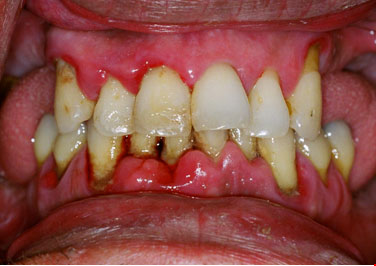Introduction
The main cause of periodontal disease is bacteria in the form of a sticky, colorless plaque that constantly forms at the gum line of your teeth. Many other factors however can cause periodontal (gum) disease or influence its progression.
Signs & Symptom Of Periodontal Disease
Periodontal diseases range from simple gum inflammation to serious disease that results in major damage to the soft tissue and bone that support the teeth. In the worst cases, teeth are lost.
Gingivitis
The longer plaque and calculus remain on teeth, the more harm they cause. The bacteria cause inflammation of the gums, called “gingivitis.” Where, the gums become red, swollen and bleed easily.
Periodontitis
When gingivitis is not treated, it can advance to “periodontitis” In periodontitis, gums pull away from the teeth and form “pockets” that are infected. The body’s immune system fights the bacteria as the plaque spreads and grows below the gum line. Bacterial toxins and the body’s defense fighting the infection actually start to break down the bone and connective tissue that hold teeth in place.

Complications Of Periodontal Disease
If not treated, the gum bones, and connective tissue that support the teeth are destroyed. The teeth may eventually become loose and have to be removed.
Treatment
The main goal of treatment is to control the infection. The number and types of treatment will vary, depending on the extent of the gum disease. Any type of treatment requires that the patient keep up good daily care at home. Additionally, modifying certain behaviors, such as quitting tobacco use, might also be suggested as a way to improve treatment outcome.
- Non-surgical periodontal treatment, includes scaling and root planing (a careful cleaning of the root surfaces to remove plaque and calculus from deep periodontal pockets and to smooth the tooth root to remove bacterial toxins), followed by adjunctive therapy such antimicrobials as needed on a case-by-case basis. “Gingivitis” is a mild form of gum disease that can usually be reversed with daily brushing and flossing, and regular cleaning by a dentist. This form of gum disease does not include any loss of bone and tissue that hold teeth in place. After scaling, many patients may not require any further active treatment. However, the majority of patients will require ongoing maintenance therapy to sustain health.
If non-surgical therapy does not achieve periodontal health, surgery may be indicated to restore periodontal anatomy damaged by periodontal diseases and to facilitate oral hygiene practices.
Some of the surgical treatment for periodontal disease include:
- Open debridement- this involves removing calculus and debris from the root surfaces in deep pockets.
- Bone grafting – this is where patient’s own bone or artificial bone material is placed in defect sites (i.e. areas with bone loss)
- Guided Tissue Regeneration – this is where a membrane is placed between the bone and gums to encourage new growth of periodontal tissues
What Is Your Role As A Patient In Periodontal Treatment?
Successful of treatment depends on your ability to maintain good oral hygiene at home. Follow the instructions of your dentist / periodontist and never fail to keep your dental appointments.
It is especially important after surgery that you follow the post-operative instructions (such as taking your medications and informing your periodontist if there are any problems (for example if you develop a swelling or fever).
| Last reviewed | : | 20 April 2012 |
| Writer | : | Dr. Uma Subramaniam |







